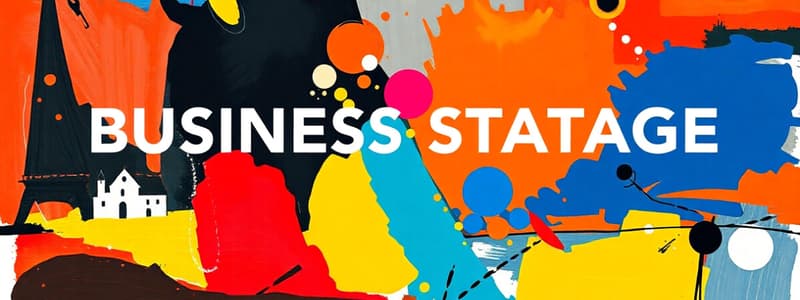Podcast
Questions and Answers
What is a core aspect of competitive strategy?
What is a core aspect of competitive strategy?
- Reducing customer service quality
- Minimizing brand recognition
- Focusing solely on product development
- Achieving competitive advantage (correct)
Which of the following contributes to a sustainable competitive advantage?
Which of the following contributes to a sustainable competitive advantage?
- Lower marketing costs
- Creating greater value than costs (correct)
- Expanding customer service hours
- Higher price than competitors
What is one way to achieve cost leadership through input costs?
What is one way to achieve cost leadership through input costs?
- Increasing marketing expenses
- Using high-skilled labor exclusively
- Implementing advanced technology for production
- Outsourcing to developing countries (correct)
What type of cost advantage is achieved through economies of scale?
What type of cost advantage is achieved through economies of scale?
According to Porter, which of the following is NOT a fundamental means of achieving competitive advantage?
According to Porter, which of the following is NOT a fundamental means of achieving competitive advantage?
What does a cost-leadership strategy primarily focus on?
What does a cost-leadership strategy primarily focus on?
How does experience contribute to cost leadership?
How does experience contribute to cost leadership?
What distinguishes a company with a differentiation strategy?
What distinguishes a company with a differentiation strategy?
What kind of efficiency can be designed in at the outset according to cost leadership strategies?
What kind of efficiency can be designed in at the outset according to cost leadership strategies?
What is a crucial requirement for a successful cost leadership strategy?
What is a crucial requirement for a successful cost leadership strategy?
What can happen to a business without a competitive advantage?
What can happen to a business without a competitive advantage?
What does Porter emphasize as a requirement alongside the lowest cost in cost leadership?
What does Porter emphasize as a requirement alongside the lowest cost in cost leadership?
Which feature does NOT describe an organization striving for competitive advantage?
Which feature does NOT describe an organization striving for competitive advantage?
What scope of customers can an organization choose to focus on, according to Porter?
What scope of customers can an organization choose to focus on, according to Porter?
Which of the following is not a type of efficiency gained from experience as mentioned in the content?
Which of the following is not a type of efficiency gained from experience as mentioned in the content?
Which method is suggested for organizations to reduce costs in customer interaction?
Which method is suggested for organizations to reduce costs in customer interaction?
What is the primary benefit of parity strategy for cost-leaders?
What is the primary benefit of parity strategy for cost-leaders?
Which of the following best describes the proximity strategy for cost-leaders?
Which of the following best describes the proximity strategy for cost-leaders?
What is a key characteristic of a differentiation strategy?
What is a key characteristic of a differentiation strategy?
In clothing retail, which of the following is an example of differentiation?
In clothing retail, which of the following is an example of differentiation?
Which aspect is NOT typically considered in pursuing a differentiation strategy?
Which aspect is NOT typically considered in pursuing a differentiation strategy?
What is a potential drawback of pursuing a differentiation strategy?
What is a potential drawback of pursuing a differentiation strategy?
Which of the following accurately defines market standards in the context of cost-leaders?
Which of the following accurately defines market standards in the context of cost-leaders?
How does customer relationship play a role in differentiation strategy?
How does customer relationship play a role in differentiation strategy?
What is a key characteristic of a focus strategy?
What is a key characteristic of a focus strategy?
Which of the following companies is an example of a cost focus strategy?
Which of the following companies is an example of a cost focus strategy?
What is a differentiation focus strategy primarily concerned with?
What is a differentiation focus strategy primarily concerned with?
Which of the following is NOT a key factor for successful focus strategies?
Which of the following is NOT a key factor for successful focus strategies?
What defines a hybrid strategy?
What defines a hybrid strategy?
How does a focus strategy achieve competitive advantage?
How does a focus strategy achieve competitive advantage?
Which airline exemplifies both a differentiation strategy and a lowest-cost position?
Which airline exemplifies both a differentiation strategy and a lowest-cost position?
Which of the following is a potential condition for a hybrid strategy's success?
Which of the following is a potential condition for a hybrid strategy's success?
Flashcards
Competitive Advantage
Competitive Advantage
The ability of a company, business unit or organization to create value for its customers that is greater than the costs of supplying them and superior to that of rivals.
Cost-Leadership Strategy
Cost-Leadership Strategy
A strategic approach focused on achieving and maintaining a cost advantage compared to competitors.
Differentiation Strategy
Differentiation Strategy
A strategic approach that emphasizes creating unique and differentiated products or services that customers value and are willing to pay a premium for.
Scope
Scope
Signup and view all the flashcards
Focus Strategy
Focus Strategy
Signup and view all the flashcards
Generic Competitive Strategies
Generic Competitive Strategies
Signup and view all the flashcards
Competitive Strategy
Competitive Strategy
Signup and view all the flashcards
Lack of Competitive Advantage
Lack of Competitive Advantage
Signup and view all the flashcards
Cost-Leader Parity
Cost-Leader Parity
Signup and view all the flashcards
Cost-Leader Proximity
Cost-Leader Proximity
Signup and view all the flashcards
Points of Differentiation
Points of Differentiation
Signup and view all the flashcards
Customer Relationship Differentiation
Customer Relationship Differentiation
Signup and view all the flashcards
Complements Differentiation
Complements Differentiation
Signup and view all the flashcards
Marketing and Reputation Differentiation
Marketing and Reputation Differentiation
Signup and view all the flashcards
Price Premium
Price Premium
Signup and view all the flashcards
Economies of Scale
Economies of Scale
Signup and view all the flashcards
Experience Curve Effect
Experience Curve Effect
Signup and view all the flashcards
Product/Process Design for Cost Leadership
Product/Process Design for Cost Leadership
Signup and view all the flashcards
Lowest Cost Requirement for Cost Leadership
Lowest Cost Requirement for Cost Leadership
Signup and view all the flashcards
Market Standards Requirement for Cost Leadership
Market Standards Requirement for Cost Leadership
Signup and view all the flashcards
Outsourcing to Developing Countries
Outsourcing to Developing Countries
Signup and view all the flashcards
Types of Experience Curve Efficiencies
Types of Experience Curve Efficiencies
Signup and view all the flashcards
Cost Focus Strategy
Cost Focus Strategy
Signup and view all the flashcards
Differentiation Focus Strategy
Differentiation Focus Strategy
Signup and view all the flashcards
Hybrid Strategy
Hybrid Strategy
Signup and view all the flashcards
Cost Focus in Differentiator
Cost Focus in Differentiator
Signup and view all the flashcards
Focuser
Focuser
Signup and view all the flashcards
Organizational Separations
Organizational Separations
Signup and view all the flashcards
Focus Strategy Advantage
Focus Strategy Advantage
Signup and view all the flashcards
Study Notes
Business Strategy
- Business strategy is about choices concerning how a business positions itself against its competitors.
- It involves decisions about products, industries, and markets to pursue.
- Strategy methods include organic, acquisition or alliance approaches.
Introduction
- Competitive strategy focuses on how a company achieves its competitive advantage in a specific domain.
- It comprises costs, product/service features, and branding.
- Competitive advantage means creating value for consumers that exceeds the costs of production and surpasses rivals' offerings.
Two Features of Competitive Advantage
- To be competitive, an organization must guarantee consumers perceive sufficient value to justify purchasing the product or service over its competitors.
- Organizations must be able to create more value for their customers than their competitors to maintain a competitive advantage.
- In the absence of competitive advantage, strategies become vulnerable to rivals with superior products or lower prices.
Generic Competitive Strategies
- Generic strategies are different methods to compete. Examples are cost leadership, differentiation, and focus.
- Cost leadership aims at delivering the lowest possible cost to consumers.
- Differentiation involves offering unique features or qualities to consumers.
- Focus strategy targets a subset of consumers with specific needs.
Cost Leadership Strategy
-
The goal is to achieve lowest cost among competitors in a specific industry/domain.
-
Cost drivers include input costs, economies of scale, experience, and product/process design.
-
Input costs (e.g. outsourcing to developing countries) are a critical factor.
-
Economies of scale impact costs. Industries with high fixed costs can benefit from cost reductions.
-
Accumulated experience within an organization leads to reduced production costs.
-
Efficient designs/processes can minimize costs from the beginning.
-
Organizations can reduce costs by strategically acquiring components, using low-cost online interactions, or considering a product's lifecycle costs.
-
Key principles include maintaining the lowest cost position among competitors and ensuring that competitors with higher costs are vulnerable.
-
Cost-leadership strategies need not compromise the quality expected by consumers.
-
Cost leaders may opt for either parity with competitors or attempt to strategically match quality to remain competitive.
Differentiation Strategy
-
Differentiating a product/service involves creating uniqueness valued by consumers enough to warrant a price premium.
-
Relevant points of differentiation vary across and within markets.
-
Diverse differentiation dimensions exist, enabling companies to target distinct customer segments. Examples can include retail stores (location, size, fashion), automotive design (safety, style).
-
Differentiation approaches also consider customer relationships, customer service, marketing aspects, and product/service complements.
-
Organizations can focus efforts on product attributes, relationships with customers, marketing and reputation, or product complements to develop a differentiated strategy.
-
Higher prices often accompany differentiation strategies, but meticulous cost management is still crucial, especially in areas external to the unique elements.
Focus Strategy
-
Narrowing the target market, focusing on serving specific customer segments, is the key aspect.
-
Focus strategies can be further divided into two forms: cost focus and differentiation focus.
-
The cost focus version strives for reduced costs while serving a particular consumer group.
-
Differentiation focus helps to establish highly valued products/services for narrow segments.
-
These strategic approaches help focusers to develop highly valued products/services and gain market recognition and customer loyalty.
-
Success depends heavily on distinctly segmented needs, value chains, and viable economies.
Hybrid Strategy
- Hybrid strategy incorporates multiple generic strategies.
- Some companies initially adopt one strategy and later integrate others to improve their position against competitors
- Companies may choose to incorporate one or more business strategies with different structures to better serve their needs.
- Hybrid strategies can be employed in organizational or technological aspects, allowing flexibility in responding to competitive pressures.
Studying That Suits You
Use AI to generate personalized quizzes and flashcards to suit your learning preferences.



